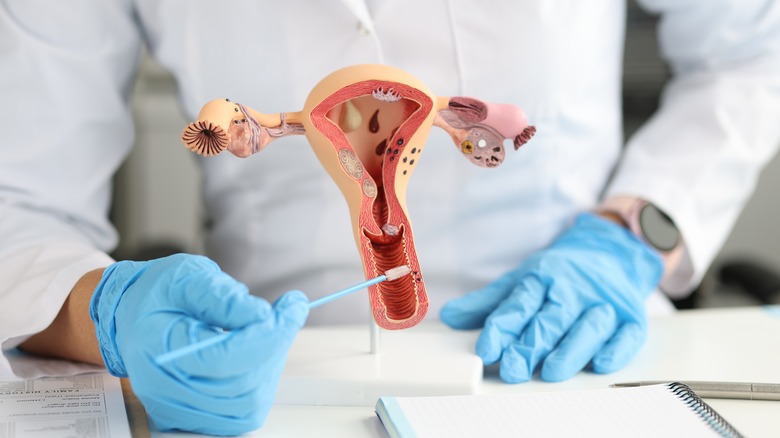What To Expect After A D&C Procedure, According To A Leading OB/GYN
Believe it or not, sexual and reproductive health plays an integral role in one's overall health. In fact, having adequate access to sexual and reproductive health care services, including abortion and other related procedures, is essential to both your physical health and emotional well-being. Now that the Supreme Court has overturned Roe v. Wade, ending the constitutional right to abortion, the future of reproductive health care is uncertain and uneven across the country (via Motherly).
As a result, access to safe and legal reproductive health services drastically varies from state to state, with some states completely banning certain life-saving procedures and medications. One important and potential life-saving reproductive procedure that is now either illegal or severely restricted in certain states is known as a dilation and curettage (D&C). In an exclusive interview with Health Digest, Dr. Amir Marashi, MD, FACS, FACOG, and the founder of Cerē, explains what a D&C is and tells us what to expect after the procedure.
What is a D&C procedure?
A D&C is a minor gynecological procedure that involves removing tissue from inside the uterus, according to Marashi. "D&C is a short surgical procedure in which the cervix is dilated, and an instrument is used to remove and/or sample the uterine lining," Marashi says. During a D&C procedure, a clamp and speculum are inserted into the vagina to help open the cervix and hold it in place (via Cleveland Clinic).
Afterward, the "cervix is dilated with a series of slender rods" and a suction or scraping device, known as a curette, is used to remove tissue from the lining of the uterus. "A device called a cannula is sometimes used to suction any remaining tissue from the uterus," Marashi shares. Since this is a short and simple procedure, it is usually performed by a gynecologist or obstetrician in an outpatient office and typically lasts around 10 minutes.
Why is this procedure performed?
As it turns out, there are a number of different reasons why this type of gynecological procedure is performed. "One reason is to remove uterine tissue during or after a miscarriage or abortion," Marashi explains. Doctors can also perform D&C procedures to help remove small pieces of the placenta after childbirth in order to help prevent infection or even heavy bleeding (via WebMD). In addition, Marashi says a D&C can be performed to help "diagnose and treat abnormal" bleeding inside the uterus.
"In this process, a sample of uterine tissue is looked at under a microscope," Marashi shares. "Fibroids, polyps, uterine cancer, and hormonal imbalances can be evaluated." Furthermore, D&C procedures can be used to help remove intrauterine devices (IUDs), extract and examine potentially cancerous tumors, remove infected tissue caused by pelvic inflammatory disease (PID), and determine the cause of heavy bleeding during menstruation (via Healthline).
What does the post-surgery recovery period look like?
While a D&C procedure typically only takes around 10 to 15 minutes to perform, the post-surgery recovery period can last a little bit longer. "The patient usually waits in the recovery room for around an hour, but sometimes up to 5 hours (this depends on the type of anesthesia that is used)," Marashi says. After you've waited in the recovery room for the allotted time period, you can head home.
Since you won't be able to drive immediately after the procedure, however, you will need to arrange for a friend or family member to take you home (via WebMD). If you underwent general anesthesia, you should expect to feel groggy for a little while and may even experience some brief nausea and vomiting, but this shouldn't last very long. "Depending on the duration of side effects of anesthesia, a patient can usually return to normal activities within 24 hours," Marashi shares.
What are the potential side effects of a D&C?
It's very common to experience mild side effects, like cramping, bleeding, and light spotting, after undergoing a D&C procedure, according to Marashi. Because of this, you should make sure you wear a menstrual pad for a day or two after the procedure (via Healthline). But whatever you do, don't use a tampon right away. As it turns out, inserting a tampon too soon after the procedure can potentially increase your risk of infection. To reduce mild cramping and discomfort, you can take over-the-counter pain relievers.
While very rare, it is possible to experience more serious side effects following a D&C, including a damaged cervix or blood vessels and even uterine perforation. "If a D&C is performed incorrectly, or if a patient undergoes too many of these procedures, scar tissue can form inside of the uterus, which can sometimes cause changes in menstrual flow, and infertility," Marashi explains. "This is called Asherman Syndrome."





